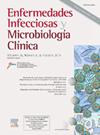通过全国性介入监测计划降低择期结直肠手术的手术部位感染率。队列研究
IF 2.6
4区 医学
Q3 INFECTIOUS DISEASES
Enfermedades infecciosas y microbiologia clinica
Pub Date : 2025-01-13
DOI:10.1016/j.eimc.2024.04.012
引用次数: 0
摘要
结直肠手术是所有腹部手术中手术部位感染发生率最高的手术。流行病学监测是降低SSI发生率的极好手段,但其效果可能有时间限制,需要定期监测。本研究分析了介入监测方案在降低择期结直肠手术后SSI发生率方面的有效性。方法:对择期结直肠手术患者15年SSI监测方案进行简短分析。前瞻性收集的数据按5年(第1、2和3期)分层,并调查SSI率、住院时间、再入院率、死亡率和微生物病因学。结果共纳入64,074例手术,其中结肠手术42,665例,直肠手术21,409例。结肠手术中SSI的总发生率从第1期的19.6%下降到第3期的7.6% (rho = - 0.961)。第1期器官空间SSI (O/S-SSI)为8.3%,第3期为4.7% (rho = - 0.815)。在直肠手术中,总体SSI从20.6%下降到12.8% (rho = - 0.839), O/S-SSI从8.5%下降到8.3%,后者的差异无统计学意义。达到最大减少SSI的干预措施是包括六项措施的预防性一揽子措施。住院时间和死亡率下降,而出院和再入院后的ssi增加。在切口和O/S-SSI中检测到革兰氏阳性球菌和真菌的增加,革兰氏阴性细菌和厌氧菌的减少。结论:对SSI发生率的详细分析有助于设计降低其发生率的策略。介入监测方案在降低结直肠手术SSI发生率方面是有效的。本文章由计算机程序翻译,如有差异,请以英文原文为准。
Reduction of surgical site infection rates in elective colorectal surgery by means of a nationwide interventional surveillance programme. A cohort study
Introduction
Colorectal surgery has the highest surgical site infection (SSI) rates of all abdominal surgeries. Epidemiological surveillance is an excellent instrument to reduce SSI rates, but its effects may be time-limited and need to be monitored periodically. This study analyses the effectiveness of an interventional surveillance programme with regard to reducing SSI rates after elective colorectal surgery.
Methods
Cohort study analysing a SSI surveillance programme in elective colorectal surgery over a 15-year period. Prospectively collected data were stratified by 5-year periods (Periods 1, 2 and 3), and SSI rates, length of stay, readmission, mortality and microbiological aetiology were investigated.
Results
A total of 64,074 operations were included (42,665 colon surgery and 21,409 rectal surgery). Overall SSI incidence in colon surgery fell from 19.6% in Period 1 to 7.6% in Period 3 (rho = −0.961). Organ-space SSI (O/S-SSI) was 8.3% in Period 1 and 4.7% in Period 3 (rho = −0.815). In rectal surgery, overall SSI fell from 20.6% to 12.8% (rho = −0.839), and O/S-SSI from 8.5% to 8.3%, the latter difference being non-significant. The intervention that achieved the greatest SSI reduction was a preventive bundle comprising six measures. Hospital stay and mortality rates decreased, while SSIs after discharge and readmissions increased. An increase in Gram-positive cocci and fungi, and reductions in Gram-negative bacteria and anaerobes were detected for both incisional and O/S-SSI.
Conclusions
Detailed analysis of SSI rates allows the design of strategies for reducing their incidence. An interventional surveillance programme was effective in decreasing SSI rates in colorectal surgery.
求助全文
通过发布文献求助,成功后即可免费获取论文全文。
去求助
来源期刊
CiteScore
2.10
自引率
8.00%
发文量
194
审稿时长
29 days
期刊介绍:
Hoy está universalmente reconocida la renovada y creciente importancia de la patología infecciosa: aparición de nuevos agentes patógenos, de cepas resistentes, de procesos con expresión clínica hasta ahora desconocida, de cuadros de una gran complejidad. Paralelamente, la Microbiología y la Infectología Clínicas han experimentado un gran desarrollo como respuesta al reto planteado por la actual patología infecciosa. Enfermedades Infecciosas y Microbiología Clínica es la Publicación Oficial de la Sociedad Española SEIMC. Cumple con la garantía científica de esta Sociedad, la doble función de difundir trabajos de investigación, tanto clínicos como microbiológicos, referidos a la patología infecciosa, y contribuye a la formación continuada de los interesados en aquella patología mediante artículos orientados a ese fin y elaborados por autores de la mayor calificación invitados por la revista.

 求助内容:
求助内容: 应助结果提醒方式:
应助结果提醒方式:


